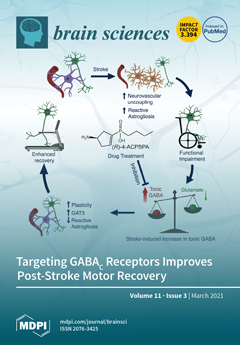Introduction. The Orbitofrontal Cortex (OFC) is a cortical structure that has implications in cognition, memory, reward anticipation, outcome evaluation, decision making, and learning. As such, OFC activity correlates with these cognitive brain abilities. Despite research suggesting race and socioeconomic status (SES) indicators such
[...] Read more.
Introduction. The Orbitofrontal Cortex (OFC) is a cortical structure that has implications in cognition, memory, reward anticipation, outcome evaluation, decision making, and learning. As such, OFC activity correlates with these cognitive brain abilities. Despite research suggesting race and socioeconomic status (SES) indicators such as parental education may be associated with OFC activity, limited knowledge exists on multiplicative effects of race and parental education on OFC activity and associated cognitive ability.
Purpose. Using functional brain imaging data from the Adolescent Brain Cognitive Development (ABCD) study, we tested the multiplicative effects of race and parental education on left lateral OFC activity during an N-Back task. In our study, we used a sociological rather than biological theory that conceptualizes race and SES as proxies of access to the opportunity structure and exposure to social adversities rather than innate and non-modifiable brain differences. We explored racial variation in the effect of parental educational attainment, a primary indicator of SES, on left lateral OFC activity during an N-Back task between Black and White 9–10 years old adolescents.
Methods. The ABCD study is a national, landmark, multi-center brain imaging investigation of American adolescents. The total sample was 4290 9–10 years old Black or White adolescents. The independent variables were SES indicators, namely family income, parental education, and neighborhood income. The primary outcome was the average beta weight for N-Back (2 back versus 0 back contrast) in ASEG ROI left OFC activity, measured by functional Magnetic Resonance Imaging (fMRI) during an N-Back task. Ethnicity, age, sex, subjective SES, and family structure were the study covariates. For data analysis, we used linear regression models.
Results. In White but not Black adolescents, parental education was associated with higher left lateral OFC activity during the N-Back task. In the pooled sample, we found a significant interaction between race and parental education on the outcome, suggesting that high parental education is associated with a larger increase in left OFC activity of White than Black adolescents.
Conclusions. For American adolescents, race and SES jointly influence left lateral OFC activity correlated with cognition, memory, decision making, and learning. Given the central role of left lateral OFC activity in learning and memory, our finding calls for additional research on contextual factors that reduce the gain of SES for Black adolescents. Cognitive inequalities are not merely due to the additive effects of race and SES but also its multiplicative effects.
Full article






